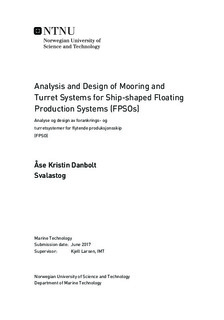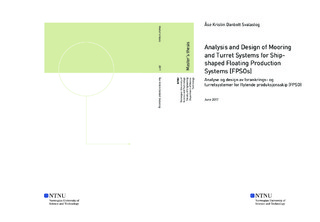| dc.description.abstract | From a marine operational point of view, a precise position and motion control of ships and other floating structures are important. In order to design a mooring system that can satisfy this, the top end motion of the mooring lines must be calculated. The excitation loads on a moored vessel are due to wind, waves and current. The wind is characterized as a static force excited by the mean wind speed, and as a low-frequency force excited by wind gusts. The waves are characterized by static mean forces, first order linear forces and second order non-linear wave forces. The current forces are considered as static forces.
The main categories of station keeping are pure mooring systems, such as spread and single-point moorings, dynamic positioning systems and thruster-assisted mooring systems. Typical arrangements are taut, semi-taut and catenary systems. Mooring lines can be divided into several segments, with different material and buoyancy elements along the line. Mooring lines are often made of chain, synthetic fibre rope, wire rope or a combination of them. Three limit states are described; intact (ULS), accidental (ALS) and fatigue (FLS).
Generally there are three different methods to compute the response of a floating structure; the frequency domain, time domain or a combined time and frequency domain approach. In the frequency domain, the non-linear restoring terms and damping terms are linearised and the low- and wave-frequency load effects are decoupled. The total contribution is then found by use of the superposition principle. In the time domain, the motions are solved simultaneously and non-linear effects are directly accounted for in the restoring and damping terms.
The FPSO in question is located in the Barents Sea on the Norwegian Continental Shelf. The ship-shaped unit has a passive turret mooring system consisting of three bundles with five anchor lines each, resulting in 15 mooring lines. The vessel has in total 11 risers, with opportunity for future risers. A coupled SIMO-RIFLEX model provided by Statoil has been used to perform simple ULS and ALS analyses in the software SIMO, by use of the time domain approach. In this thesis three following limitations are considered valid; three environmental conditions are tested, the risers are disabled and the number of required simulations are found to be 14. In addition, the turret model is simplified to a beam element with zero torsional stiffness.Two important functional requirements for the FPSO are that the integrity of the risers are maintained, provided by an offset requirement, and that the safety factor for the moorings are fulfilled.
Several analyses for the intact condition are performed for different 100-years conditions for the loaded vessel. Four additional ALS analyses are conducted for the case with the most loaded line in ballast condition; one and two anchor line failure, and two definitions of the ALS extreme weather with 10 000-year return period. The vessel offset, the mooring line tensions and the dynamic turret support forces for all cases are discussed and compared with the respective acceptance criteria. In addition, simple uplift calculations are derived for the intact condition and the condition most sensitive towards uplift.
Ship-shaped units are sensitive to low-frequency motion, and therefore the sea state with the shortest period is the most critical one. The results show that the in-line condition leads to the highest tension in the mooring lines, hence this condition is further investigated for the accidental limit states. Both one and two line failures fulfils the requirements for permanent structures operating on the Norwegian Continental Shelf provided by DNV GL. Statoil has an internal requirement for the extreme weather conditions, both extreme conditions fulfils the criteria. Comparing two definitions of the ALS extreme weather with 10 000-year return period, for the waves and wind, the waves were found to be the most critical extreme condition giving the highest responses of the ship-shaped unit and mooring system. Units with large topsides, such as semi-submersibles, are often more sensitive towards extreme wind.
The dimensioning parameter for the FPSO is the tension in the heaviest loaded line in the two anchor line failure analysis, with a margin of 0.27. | |

